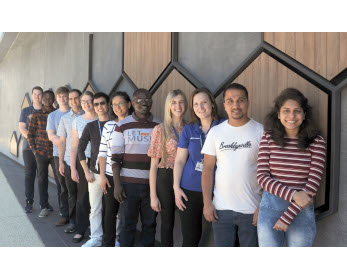- Sheriff S, Saba M, Patel R, Fisher G, Schroeder T, Arnolda G, Luo D, Warburton L, Gray E, Long G, Braithwaite J, Rizos H, Ellis LA. A scoping review of factors influencing the implementation of liquid biopsy for cancer care. J Exp Clin Cancer Res. 2025 Feb 12;44(1):50. doi: 10.1186/s13046-025-03322-w.
- Denisenko E, de Kock L, Tan A, Beasley AB, Beilin M, Jones ME, Hou R, Muirí DÓ, Bilic S, Mohan GRKA, Salfinger S, Fox S, Hmon KPW, Yeow Y, Kim Y, John R, Gilderman TS, Killingbeck E, Gray ES, Cohen PA, Yu Y, Forrest ARR. Spatial transcriptomics reveals discrete tumour microenvironments and autocrine loops within ovarian cancer subclones. Nat Commun. 2024 Apr 3;15(1):2860. doi: 10.1038/s41467-024-47271-y.
- Warburton L, Reid A, Amanuel B, Calapre L, Millward M, Gray E. Detectable ctDNA at the time of treatment cessation of ipilimumab and nivolumab for toxicity predicts disease progression in advanced melanoma patients. Front Oncol. 2023 Dec 19;13:1280730. doi: 10.3389/fonc.2023.1280730.
- Beasley AB, de Bruyn DP, Calapre L, Al-Ogaili Z, Isaacs TW, Bentel J, Reid AL, Dwarkasing RS, Pereira MR, Khattak MA, Meniawy TM, Millward M, Brosens E, de Klein A, Chen FK, Kiliҫ E, Gray ES. Detection of metastases using circulating tumour DNA in uveal melanoma. J Cancer Res Clin Oncol. 2023 Nov;149(16):14953-14963. doi: 10.1007/s00432-023-05271-3.
- Asante DB, Mohan G, Acheampong E, Ziman M, Calapre L, Meniawy TM, Gray ES and Beasley AB. Genetic analysis of heterogeneous subsets of circulating tumour cells from high grade serous ovarian carcinoma patients. Sci Rep. 2023; 13(1):2552 10.1038/s41598-023-29416-z.
- Abed A, Law N, Calapre L, Lo J, Bhat V, Bowyer S, Millward M, Gray ES. Human leucocyte antigen genotype association with the development of immune-related adverse events in patients with non-small cell lung cancer treated with single agent immunotherapy. Eur J Cancer. 2022 Sep;172:98-106. doi: 10.1016/j.ejca.2022.05.021.
- Marsavela G, McEvoy AC, Pereira MR, Reid AL, Al-Ogaili Z, Warburton L, Khattak MA, Abed A, Meniawy TM, Millward M, Ziman MR, Calapre L, Gray ES. Detection of clinical progression through plasma ctDNA in metastatic melanoma patients: a comparison to radiological progression. Br J Cancer. 2022 Feb;126(3):401-408. doi: 10.1038/s41416-021-01507-6.
No results were found

